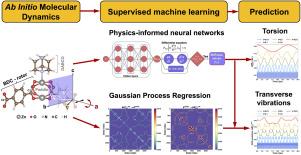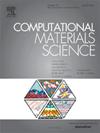Untangling linker dynamics in a metal–organic framework using ab initio molecular dynamics and physics-informed machine learning
IF 3.3
3区 材料科学
Q2 MATERIALS SCIENCE, MULTIDISCIPLINARY
引用次数: 0
Abstract
Organic linkers in metal–organic frameworks (MOFs) can display multiple degrees of freedom in their movement, and such complex dynamics are known to influence gas adsorption and diffusion, luminescence, and thermomechanical properties. Here, we have examined the torsional and transverse dynamics of 1,4-benezedicarboxylate (BDC) linkers in a Zn(BDC) (1,4-diazobicyclo [2,2,2] octane) metal–organic framework (Zn-DMOF) by using ab initio molecular dynamics (AIMD) and physics-informed machine learning (ML). AIMD was performed at 200 and 300 K to generate time-resolved data for training ML models. Neural networks (NN), constrained with classical mechanics-based equation of motions, allowed us to extract harmonic and anharmonic torsion stiffness constants from AIMD data; while Gaussian process regression (GPR) was employed to probe for statistical correlations between torsional and transverse dynamics. These supervised ML approaches revealed that BDC linkers in pristine Zn-DMOF loose their resistance to torsional motion between 200 and 300 K, and that contributed to mechanical coupling between transverse and torsion modes at the higher temperature. As an extension of this effort, we utilized NN-derived torsion-time profiles and trained-GPR models to probe the effect of functionalizing BDC linkers with bulky non-polar groups. Our ML-based analysis confirm literature reports that such attachments will hinder torsion and transverse movements, and likely facilitate gas adsorption. Thus, our combined AIMD and physics-informed ML approach can potentially facilitate MOF design strategies that require engineering of linker dynamics for targeted applications.

使用从头算分子动力学和物理信息机器学习在金属有机框架中解开链接动力学
金属-有机框架(mof)中的有机连接体在其运动中可以显示多个自由度,并且这种复杂的动力学已知会影响气体的吸附和扩散,发光和热机械性能。在这里,我们利用从头算分子动力学(AIMD)和物理信息机器学习(ML)研究了Zn2(BDC)2(1,4-重氮双环[2,2,2]辛烷)金属-有机框架(Zn-DMOF)中1,4-苯二甲酸酯(BDC)连接剂的扭转和横向动力学。在200和300 K下进行AIMD,生成用于训练ML模型的时间分辨数据。神经网络(NN)受经典力学运动方程的约束,使我们能够从AIMD数据中提取谐波和非谐波扭转刚度常数;采用高斯过程回归(GPR)分析扭振和横振之间的统计相关性。这些有监督的机器学习方法表明,原始Zn-DMOF中的BDC连接件在200至300 K之间的扭转运动阻力松动,这有助于在较高温度下横向和扭转模式之间的机械耦合。作为这项工作的延伸,我们利用神经网络衍生的扭转时间曲线和训练过的gpr模型来探索用大体积非极性基团功能化BDC连接器的效果。我们基于ml的分析证实了文献报道,这些附着物会阻碍扭转和横向运动,并可能促进气体吸附。因此,我们结合了AIMD和物理信息的ML方法,可以潜在地促进MOF设计策略,这些策略需要针对目标应用进行链接器动力学工程。
本文章由计算机程序翻译,如有差异,请以英文原文为准。
求助全文
约1分钟内获得全文
求助全文
来源期刊

Computational Materials Science
工程技术-材料科学:综合
CiteScore
6.50
自引率
6.10%
发文量
665
审稿时长
26 days
期刊介绍:
The goal of Computational Materials Science is to report on results that provide new or unique insights into, or significantly expand our understanding of, the properties of materials or phenomena associated with their design, synthesis, processing, characterization, and utilization. To be relevant to the journal, the results should be applied or applicable to specific material systems that are discussed within the submission.
 求助内容:
求助内容: 应助结果提醒方式:
应助结果提醒方式:


